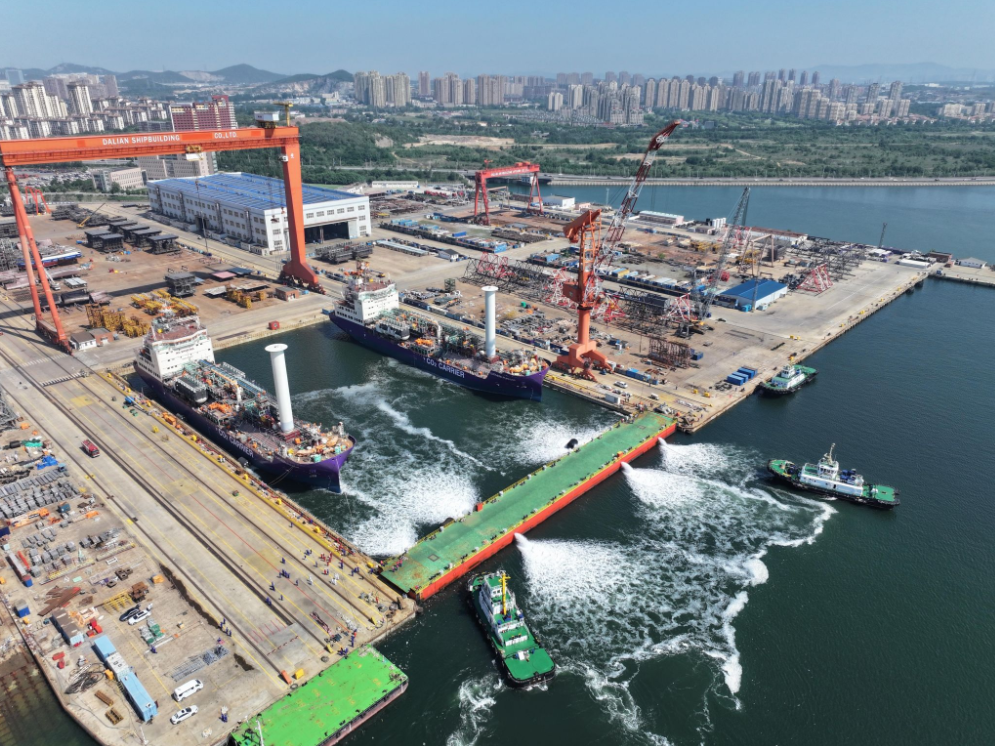Norway’s Northern Lights announced on social media that two new liquid carbon dioxide (LCO2) carriers were successfully launched at Dalian Shipbuilding Industry Corporation (DSIC), a subsidiary of China State Shipbuilding Corporation (CSSC). Northern Lights is a joint venture between Equinor, Shell, and TotalEnergies, dedicated to providing commercial carbon transportation and storage services.

This LCO2 carrier was independently developed and built by DSIC and has completely independent intellectual property rights. The vessel is approximately 130 meters long, 21.2 meters wide, and has a structural draft of 8 meters. It flies the Norwegian flag and has a capacity of 7,500 cubic meters. It uses liquefied natural gas (LNG) as its fuel.
The two new vessels launched this time are the third and fourth new LCO2 carriers in Northern Lights’ LCO2 transport fleet. Both vessels are equipped with rotary sail systems to achieve lower carbon emissions.
The new vessels will be used for cross-border carbon dioxide transport, delivering liquid carbon dioxide to permanent storage facilities on the seabed of the North Sea, just like their sister vessels, the Northern Pioneer and Northern Pathfinder. The third vessel will be managed by K Line of Japan.
The keel-laying ceremony for the fourth vessel was held in December 2024, just one year after the order was signed.
Previously, the first vessel, Northern Pioneer, completed sea trials in September 2023 and was officially delivered at the end of November. The second vessel, Northern Pathfinder, was named in June this year and will be managed by K Line Energy Shipping (UK) Limited, a subsidiary of Kawasaki Kisen Kaisha, after delivery.
Northern Lights is the world’s first company to offer commercial CO2 transport and storage services. Its CO2 receiving terminal in Øygarden, Norway, was completed at the end of September 2024. It will receive industrial CO2 from Norway and Europe. The project will also process CO2 captured by the Sercio waste-to-energy plant in Hafslund, Oslo.
As a core part of the Norwegian government-led Longship carbon capture and storage project, the Northern Lights project includes a carbon dioxide receiving terminal, subsea pipelines and injection wells, intermediate storage tanks, and onshore facilities. The first phase of the project was promoted through cooperation between the government and multiple parties, verifying the feasibility of the business model and technical route. Currently, the storage capacity has been fully reserved.
The second phase of the project will increase carbon dioxide injection capacity from 1.5 million tons per year to at least 5 million tons per year. The second phase expansion will build on existing onshore and offshore infrastructure, installing additional onshore storage tanks, constructing new terminals, increasing injection wells, and building new carbon dioxide transport ships. The second phase of development is expected to be completed and operational in the second half of 2028.
With the second phase of its development plan underway, Northern Lights continues to expand its fleet with the addition of more and larger liquid carbon dioxide carriers to meet the growing demand for carbon capture and storage.
According to previous reports, Northern Lights launched a tender for a new generation of ships in January this year and sent invitations to shipyards and shipowners. These new vessels will be larger than the previous generation, with a capacity exceeding 12,000 cubic meters, and there may be as many as 10 vessels. Northern Lights expects to complete the tender in 2025.


